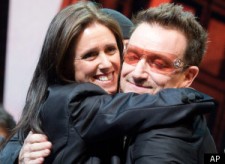“Spider-Man”: My FT Review

 Here she is, boys: my Financial Times review of “Spider-Man: Turn Off The Dark.” You may have heard of it. If not, I hope it’s cool in that cave. Full review after the jump. BTW, I checked the Weather Channel and hell indeed did freeze over last night when Julie Taymor embraced Bono at the opening.
Here she is, boys: my Financial Times review of “Spider-Man: Turn Off The Dark.” You may have heard of it. If not, I hope it’s cool in that cave. Full review after the jump. BTW, I checked the Weather Channel and hell indeed did freeze over last night when Julie Taymor embraced Bono at the opening.
After months of previews, revisions and exhaustive media coverage, the most expensive – and accident-prone – production in Broadway’s history finally makes its official debut. Some critics jumped the gun to proclaim it a gangrenous glob in February, prompting the show’s producers to purge original director Julie Taymor and order a three-week shutdown for changes under the direction of Philip William McKinley. But if you have been craving confirmation that Spider-Man: Turn Off the Dark is a disaster, you may be disappointed: this version 2.0 is pretty entertaining.
I, for one, wouldn’t have wanted to be anywhere else during the climactic battle between the Green Goblin, portrayed by the stentorian Patrick Page, and Spidey/Peter Parker, played by Reeve Carney, whose singing voice resembles that of Bono, the musical’s co-composer and co-lyricist, with the gravel sifted out.
At this moment of clock-hanging suspense, McKinley and set designer George Tsypin give us the sensation of staring into one of the sinister night-time canyons of New York City. Combined here are the production’s two unadulterated triumphs: aerial pyrotechnics and a seamless marriage of Marvel comic-book graphics and Manhattan art deco.
Minutes before, the Goblin had shown himself to be more than just a bullying baddie. He presided at a colour co-ordinated piano, in the shadow of a giant Chrysler Building cut-out, and croaked a rendition of Rodgers and Hart’s “Manhattanâ€. In the midst of a fairly dark and joyless story, the joke lights up the proceedings like a pinball machine.
Unfortunately, tipping your top hat – or, in the case of Bono’s songwriting collaborator, The Edge, doffing your knit cap – to Broadway geniuses also reminds us how second-rate your tunes are. The numbers – from a Cocteau Twins-ish “Turn Off the Dark†to a by-the-numbers U2 power ballad, “Rise Above†– are mildly engaging, nothing more.
Lyrics and melodies do little to deepen character, nor are they very integrated into the book.
That anaemic book is credited to Taymor, Glen Berger and Roberto Aguirre-Sacasa, and it is full of puzzling choices. The audience arrives knowing the basic story: nerdy Peter Parker dreams of wooing Mary Jane Watson and, once transformed into Spider-Man, is able to defeat demons and win her over. So why then does the show spend its first half hour establishing Parker’s geekiness? The book’s deficient structure ensures that we are jerked around as wearyingly as the production’s athletically gifted cast. And scenes of dialogue lack needed economy.
Such problems don’t plague rock-opera shows such as The Who’s Tommy or tauter, pop-driven shows, such as Hair or Rent. But Spider-Man demands to be evaluated as a more conventional offering. Within that context, it deserves low marks. As a visually striking spectacle, however, this extravaganza sometimes soars.
